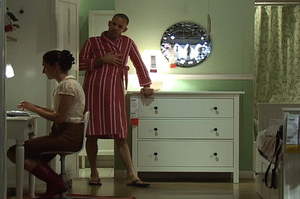This is an archive of the ArtCat Zine, 2007-2009. Please visit our new project, IDIOM.
Showing and Telling: Guy Ben-Ner at Postmasters
Guy Ben-Ner
5 January - 16 February 2008
Postmasters Gallery - 459 W. 19 St, New York NY
Some naysayers insist that contemporary conceptual art is nothing but illustration of political, philosophical, or ethical concepts already explored (more fully) by academics. The artists, they argue, are rightly excited by these ideas, but then doll up and dumb down the texts that inspired them in order to create something "new," and the commercial art world celebrates them for it. The Israeli artist Guy Ben-Ner, who has in the past decade produced some fine work, is typically exempt from such criticism, but Stealing Beauty, one of two Ben-Ner video works currently on display at Postmasters, is not.

Single channel video DVD, Courtesy Postmasters Gallery
Shot without permission in different IKEA stores near New York, Berlin, and Tel Aviv, "Stealing Beauty" follows the Ben-Ner family through a series of archetypal household routines: returning home from work, showering, surfing the Internet, washing dishes, preparing for bed. Ben-Ner gives these activities a sitcom treatment, right down to the happy, if vaguely maddening, musical jingle used for scene transitions and credits. Watching the family "live" in the IKEA showrooms is as funny as it is unsettling. Viewers will chuckle whenever IKEA shoppers wander into the shot, and some scenes — for example, a rubber-gloved Amir, Ben-Ner's young son, washes imaginary dishes in a kitchen showroom while a puzzled shopper looks on — are satisfying slapstick. Yet every shot is populated with bold IKEA price tags, hanging from the wall sconces, book shelves, lamps and chairs. When Guy and his wife, Nava, get into bed, we can’t ignore a framed photograph of a smiling blonde couple — not Guy and Nava — propped on the night stand. The point is clear: the Ben-Ners, like all of us today (to one degree or another), adopt a manufactured individuality and conform through consumption.

Single channel video DVD, Courtesy Postmasters Gallery
Had Ben-Ner kept things simple, Stealing Beauty may well have been brilliant. Unfortunately, the artist's smart provocation and humor are soon overburdened by distractingly didactic dialogue; Ben-Ner and his family spend so much time talking about principals of ownership and private property that all the charm and mischief of the project evaporates. The apotheosis, appropriately, comes at the video's end, when Ben-Ner's two children, Elia and Amir, present an ostentatious manifesto of thievery (rendered unintentionally trivial by their very preciousness) in front of a black flag emblazoned with skull, hammer and sickle. Idealistic and mildly anarchistic myself, I should be nodding in agreement with Ben-Ner, but the artist has elected to tell rather than show, and all of the ideas presented are more intelligently presented by his sources, the likes of Marx, Proudhon, Godwin, Kropotkin, and Thoreau.
After watching Stealing Beauty twice, I grumbled my way into Postmasters' back gallery to see if I'd give it to you if I could but I borrowed it might redeem the artist. And so it does. The video includes no dialogue, but better expresses the same ideas Ben-Ner peddles in Stealing Beauty.
To watch "I'd give it to you," viewers must become participants, mounting a stationary bicycle and pedaling in order to propel the narrative displayed on a monitor positioned above the bicycle's handlebars. (Yes, backward pedaling will cause the video to reverse direction, and slower pedaling will produce slow-motion on screen. Good and good.) The bicycling viewer watches as Ben-Ner and his two children examine famous works of art in a museum. The works are all sculptural — Marcel Duchamp's Bicycle Wheel, Pablo Picasso's Bull's Head, Jean Tinguely's Cyclograveur, Joseph Beuys' Zerstorte Batterie — and each includes a part (or parts) of a bicycle. After Guy, Elia and Amir admire the four works for a sufficiently appropriate amount of time, they (literally) deconstruct the sculptures so that they may build a working bicycle with the components. It's whimsically ingenious - after having removed the bicycle wheel from Duchamp's renowned work, Amir moves the stool portion of the sculpture and clambers atop it to reach Picasso's wall mounted Bull's Head - but the anarchic gesture is clear: useless (yet precious) commodities are destroyed to produce a utilitarian (but again worthless) object.

2007, Single channel video DVD, Courtesy Postmasters Gallery
Once the art bicycle is assembled, Ben-Ner and his children head to a riverside park, drop acid, and bike about the grounds. This sequence is a reimagining of Rodney Graham's The Phonokinetoscope — a video in which the Canadian artist is filmed dosing and riding a bicycle through Berlin's Tiergarten — as a family affair. Here again, Ben-Ner critiques an existing work of art. Graham's hallucinogenic meditation is essentially selfish, a metaphor for the often solitary, internalized act of creation; Ben-Ner and his children frame that same act as a shared experience.
I'd give it to you if I could but I borrowed it is amusing, affecting and earnest. In an art world dominated by cynical or escapist gestures, the video is a welcome reminder that optimistic works can still inspire viewers and that less is, in fact, more.
ZINE
HOME
TIPS / COMMENTS
CATEGORIES
CONTRIBUTORS
- Greg Afinogenov
- B. Blagojevic
- Adda Birnir
- Susannah Edelbaum
- Julie Fishkin
- Paddy Johnson
- Jessica Loudis
- Christopher Reiger
- Andrew Robinson
- Peter J. Russo
- Blythe Sheldon
- S.C.Squibb
- Hrag Vartanian
